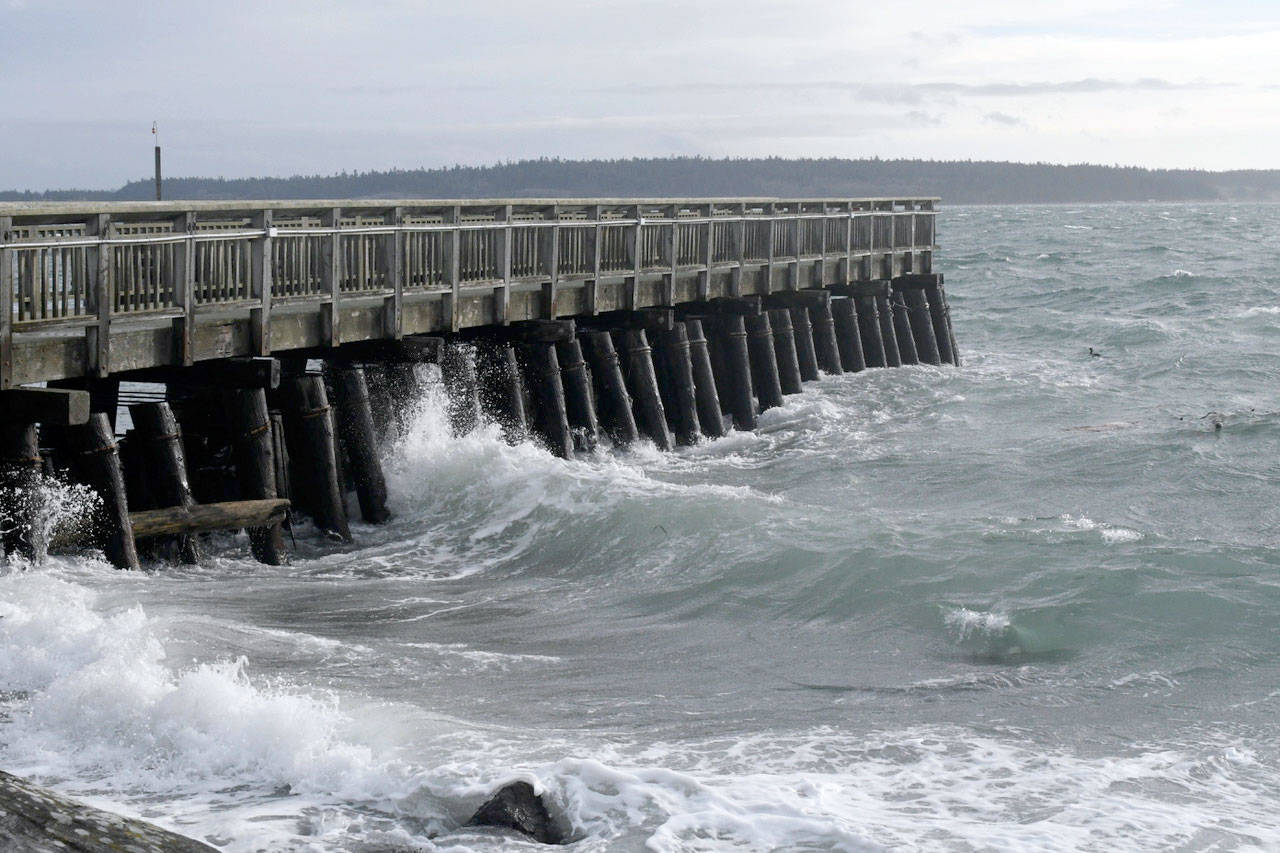PORT TOWNSEND — The Point Hudson jetty replacement project took on new life during a discussion by Port of Port Townsend commissioners at their business meeting Wednesday.
A group of interested individuals have asked that the jetty be studied with a wider lens, to include the possibility of historic status.
Capt. Robert D’arcy, project manager of the schooner Martha, questioned whether the Point Hudson jetty has a national historic designation. And if it does, how can that designation help the Port of Port Townsend rebuild it?
He and a group of interested citizens created a historical timeline of Point Hudson to trace its beginning from 1792 to today.
Interim Port Executive Director Jim Pivarnik said the port staff is looking into the matter with an open mind.
A group of stakeholders want to see the jetty replaced “in-kind” rather than proceeding with the previously approved steel combi-wall that they say looks much different that what currently exists.
“The port needs to identify what they want built there,” Pivarnik said. “Six years ago, the goal was how to rebuild this breakwater in the most efficient, effective and most cost-effective way. That came back to modern technology.
“We looked at what other marinas were doing. We looked at Shilshole, Elliot Bay and all the others, and they were using a combi-wall infrastructure.”
Pivarnik said the design and construction needs to be durable, last a long time and give better protection to the marina than the harbor currently has.
“That led us down the road to a combi-wall,” he said.
“Where we failed was outreach,” Pivarnik said. “We made a decision in a vacuum. And that vacuum continued.”
“Carol Hasse and her group came together and the response was ‘it’s too late. We’ve designed it, permitted it and it has gone out to bid. We cannot go back to square one.’ ”
He said the port did not engage with the public as well as it should have.
Today, the design is still a point of disagreement.
“The question becomes do we want to throw that $700,000 that’s already been spent on consulting, design and permitting away?” Pivarnik said. “Do we want to rethink this?”
Pivarnik said permitting has to come not just from the city of Port Townsend, but also from various agencies including the Joint Aquatic Resource Permit Application (JARPA) that is managed by the Army Corps of Engineers.
“Tribal interests have to weigh in. U.S. Fish and Wildlife, state Fish and Wildlife … it’s been consolidated to one permit for everywhere,” he said.
According to Pivarnik, proponents have said that if there is a historic designation, permitting will be easier and the money will flow freely from the federal government. The design would be a “replace in-kind” — without the creosote wood pilings.
“If that were the case, the only difference is that the wood piles would be replaced by steel. It would still be a cage rubble mound,” he said.
However, he said there are negatives to this plan.
“When the wind blows a certain way out of the southeast, the harbor is not protected very well. Even in a big windstorm, the waves can still come through the breakwater.
“What engineers tried to do with the new design is to have a combination of rock and steel that would protect the marina better in that scenario.”
Pivarnik said he has been meeting with several stakeholders in the community. He said he sees an opportunity to work with the community and wants to look deep into several possibilities.
“We can’t afford what we permitted,” he said. “In our capital plan, we’re not looking to replace the breakwater for two years. Let’s take that two years and evaluate, listen and have other engineering firms weigh in to see what can be done without spending a lot of money.”
He said there are public infrastructure funds available and applying for a grant for study alternatives is one scenario.
“We are going to do a dispassionate evaluation of the pros and cons,” he said.
Staff is open to this historic designation and will ask some community members to do some more historical digging on the matter.
A historical timeline of Point Hudson, complete with photos from the Jefferson County Historical Society, was prepared by Ron Moller, Ashlyn Brown and D’arcy and presented to the commissioners. The document outlines the process of building Point Hudson with a focus on the breakwater and jetty.
In 1934, the harbor was reshaped and the project was included on the federal government’s public works program. It was completed in 1936.
In 1939, the U.S. Coast Guard acquired the site as a training station and stayed on through World War II under command of the U.S. Navy.
In 1947, Point Hudson was transferred to the War Assets Administration as surplus property, and then was transferred to an Army Unit at Fort Worden for training through the Korean War.
In 1953, Fort Worden was closed and the Army deactivated Point Hudson.
In 1956, the Port of Port Townsend purchased Point Hudson from the U.S. General Services Administration.
In 1969, Point Hudson jetty received its first major repairs since it was constructed in 1936, including a second row of timber piles and new steel ties.
In 1996, Point Hudson jetty repairs were made including new piles and steel cables to the seaward ends of both breakwaters and supplemental rock was added.
________
Jefferson County Editor/Reporter Jeannie McMacken can be reached at 360-385-2335 or at jmcmacken@peninsuladailynews.com.

